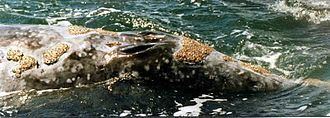Length Remora: 30 – 90 cm | ||
 | ||
Representative species Live sharksucker, Common remora, Balanus glandula, Balanus perforatus, Slender suckerfish | ||
Epibionts on a copepods
An epibiont (from the Ancient Greek meaning living on top of) is an organism that lives on the surface of another living organism. An epibiont is by definition harmless to its host; in this sense, the relationship between the two organisms can be considered neutralistic or commensalistic (as opposed to, for example, parasitic, in which case one organism benefits at the expense of the other, or mutualistic, in which both organisms obtain some explicit benefit from their coexistence). Examples of common epibionts are barnacles, remoras and algae, many of which live on the surfaces of larger marine organisms such as whales, sharks, sea turtles and mangrove trees. The host of the epibiont is typically referred to as the basibiont (living underneath).
